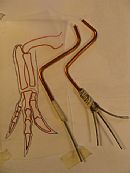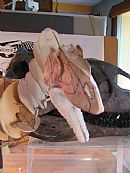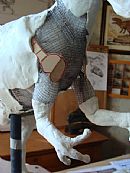 |

           
 
Members
Login
|
|

|
|
| |

 |
 |
Sculpting "Specter of Howe Quarry"
In sculpting and producing the 48" long, 20 1/2" high bronze of "Specter of Howe Quarry" (Allosaurus and Prey) commissioned in 2011 by John Goster, the first step after research was to create a basswood and heavy wire armature. The proportions precisely corresponded to Gregory S. Paul's highly accurate skeletal reconstruction on paper, which served as a template for the shapes.

|

 |
 |
Sculpting "Specter of Howe Quarry"
With the paper template as a guide for the forelimbs and feet, separate lengths (for fingers and toes) of aluminum wire were bundled and attached to the heavy wire main arm and leg. Their flexibility allowed them to be easily re-bent when needed.

|

 |
 |
Sculpting "Specter of Howe Quarry"
To define the outermost main body dimensions of the dinosaur and support the outer armature, the main armature frame is given cross sections of basswood. The spaces in between (here, starting withe skull) receive sections of styrofoam-- these fill in the spaces and can easily be shaped but still offer some rigid support.

|

 |
 |
Sculpting "Specter of Howe Quarry"
The sculpture's skull, with its subtle shapes and dimensions, itself forms the armature for the outer fleshy details of the head. Two laterally facing sides are cut like cookie dough from a tracing of the paper template overlaid on a sheet of Sculpey clay with an X-acto knife, and baked to moderate flexibility. After adding more clay, the fully 3-dimensional skull and jaws are baked for attachment to the main armature after gluing in pre-sculpted and hardened teeth.

|

 |
 |
Sculpting "Specter of Howe Quarry"
The hardened, completed skull attached to the main armature.

|

 |
 |
Sculpting "Specter of Howe Quarry"
With the temporary addition (for fit) of the small armature for the Diplodocus juvenile and styrofoam spacers in the body, the armature is ready for the flexible mesh surface.

|
|
|
Sculpting "Specter of Howe Quarry"
Flexible sheets of plastic mesh are glued and tied with fine wire onto the main armature. This surface will receive thin, 1/4" sheets of Sculpey "skin" which will be draped and glued into position over the styrofoam/mesh shapes. Reducing the amount of clay whenever possible makes the final sculpture much lighter and easier to manage.

|

 |
 |
Sculpting "Specter of Howe Quarry"
Initial modeling of the forearm has begun, along with draping the 1/4" "skin". During the final sculpting, skin and scale textures are "stamped" into the soft clay using several hardened Sculpey negative molds, ranging from large, coarse patterns to smaller and finer ones, depending on the location on the body.

|

 |
 |
Sculpting "Specter of Howe Quarry"
The nearly completed Allosaurus sculpture, awaiting modeling of the base and installation of the baby Diplodocus.

|

 |
 |
Sculpting "Specter of Howe Quarry"
The completed modeling of Allosaurus' head. Pre-sculpted and hardened dorsal and lateral scutes were glued onto the soft Sculpey "skin", after which the entire outer surface was progressively "baked" at low, then high temperatures with a hair dryer, as baking in an oven would have melted and deformed the interior plastic mesh and styrofoam. The hardened sculpture was then coated with lacquer to create a non-porous, uniformly hard surface.

|

 |
 |
Sculpting "Specter of Howe Quarry"
To facilitate molding and casting, the finished sculpture was carefully sectioned into several pieces and the cut ends capped with clay. This photo shows the wax mold of the right foot, attached to the base, surrounded by the silicone inner mold; this received an outer mold of reinforced fiberglas-resin.

|

 |
 |
Sculpting "Specter of Howe Quarry"
A completed wax mold section for the main body. To allow insertion of the finished bronze cast baby Diplodocus into the closed jaws, the upper head of the Allosaurus was separately molded and cast. After the polychromed bronze cast of the baby was fixed into position, the upper head was welded on.

|

 |
 |
Sculpting "Specter of Howe Quarry"
After the wax body sections were cast, wax sprue channels were attached prior to the entire cast being molded with liquid ceramic clay. This was first poured around the wax molds, then fired in a kiln. The now hardened ceramic molds, from which the wax casts had melted and drained, was then ready for the molten bronze pouring.

|

 |
 |
Sculpting "Specter of Howe Quarry"
The sections of raw bronze casts, now re-assembled by welding, then required sanding, filing, buffing and other types of metal detailing to disguise weld lines and ready the completed cast for polychroming, or colorizing. This is done by brushing a series of chemical washes over the raw metal surface, after each wash subjecting them to a low-to-high acetyline blowtorch flame. Through burning and oxidizing the chemicals, this changes the chemistry to produce subtle local color. This photo shows the finished colors of the Allosaurus' left body.

|

 |
 |
Sculpting "Specter of Howe Quarry"
Closeup detail of the polychromed neck.

|

 |
 |
Sculpting "Specter of Howe Quarry"
"Specter of Howe Quarry", right view of the finished sculpture.

|
|
|
|
| |
 |
|
|
 |
 |
|

|
|